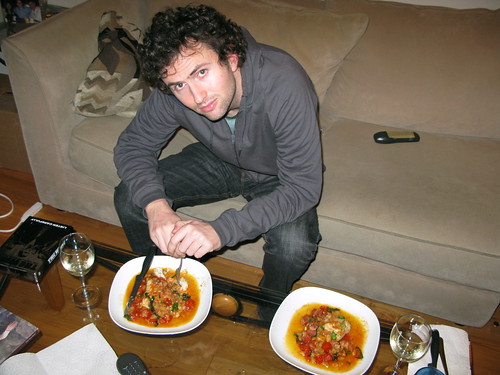Molly Stevens' Braised Monkfish with Cherry Tomatoes & Basil
"Now is the winter of our Molly Stevens," I wanted to say at the start of this winter. I wanted to say that because Molly Stevens' book, All About Braising, is one of my all-time favorite cookbooks. I love this book because the recipes are flawless and, not only that, the results always exceed my expectations. Craig will never think of parsnips the same way again after Molly's Chicken Breasts Braised with Hard Cider and Parsnips--Molly can transform anything with the flick of her magical wrist. So this winter I wanted to Molly out; I wanted to braise the whole winter through, browning, deglazing, and simmering until our kitchen itself was a braise. Only it never really got that cold and, truth be told, I was often so tired from Food Network meetings and tapings that a long braise didn't really appeal to me when I came home. (Hence the popularity, I suppose, of 30 minute meals, etc etc.)
But recently at the Chelsea Market, where Food Network is located, I met a monkfish. There's a fish store there and sitting on a counter, extravagantly arrayed, were fillets of monkfish--a truly ugly fish--and suddenly my mind leapt over the rooftops back to my bookshelf in Brooklyn where Molly's book rested. "Molly has a recipe for monkfish!" I recalled. "Monkfish braised with cherry tomatoes and basil." I bought 1 1/2 pounds of monkfish fillets and brought them home and sure enough Molly's recipe called for 1 1/2 pounds of monkfish fillets.
The recipe was a cinch to put together--the whole thing was prepped and cooked in approximately one hour--and the results, as expected, were tremendous. As I placed the plate before Craig, I felt like I was serving restaurant quality food. And, essentially, I was. "The fish is so moist and tender," said Craig, digging in. "And the sauce is so flavorful." Monkfish is called the poor man's lobster, but we didn't feel like poor men eating this. We felt like kings.
Let Molly work her magic in your kitchen after a hard day's work. Here's how you make it...
You will need:
3 Tbs extra-virgin olive oil
2 thick slices pancetta (2 ounces), cut into 1-inch pieces
1 cup finely chopped fennel (about 1/2 bulb)
Coarse salt
Pinch of crushed red pepper flakes
1/4 cup water, plus more as needed
1 pint cherry or grape tomatoes
2 garlic cloves, minced
1 1/2 pounds monkfish fillets
Freshly ground black pepper
2 Tbs shredded fresh basil
1. Combine 1 Tbs of the oil and the pancetta in a medium deep skillet (10-inch) and saute the pancetta over medium heat, stirring so that it browns evenly, until it has rendered much of its fat and is cooked but not too crisp, about 5 minutes.

With tongs or a slotted spoon, transfer to paper towels to drain.
2. Return the skillet to medium heat, add the fennel and season with salt and the red pepper flakes. Stir with a wooden spoon to coat the fennel with the oil and pancetta drippings and saute for just a minute or two, until the fennel begins to sizzle.
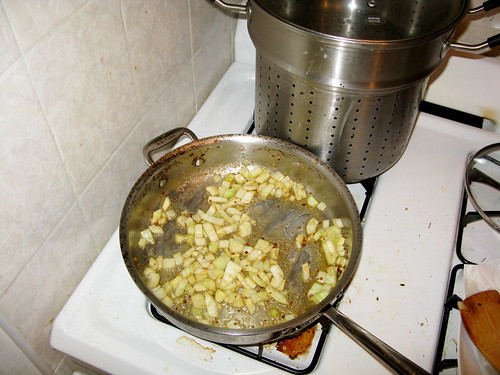
Add 1/4 cup water and stir and scrape the bottom to dislodge and dissolve any tasty cooked-on pancetta bits. Cover, reduce the heat to medium-low, and braise, stirring a few times, until the fennel is tender with just a little resistance, about 7 minutes.
Add another tablespoon of oil to the pan, along with the tomatoes and garlic.
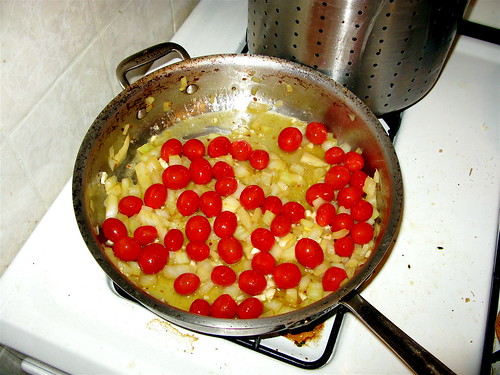
Increase the heat to medium and saute, uncovered, shaking and stirring frequently, until the tomatoes begin to burst, about 10 minutes. Stir often and scrape up the lovely caramelized crust that will develop on the bottom of the skillet. When about half the tomatoes have burst, about 12 minutes, add another 2 to 3 tablespoons of water and the pancetta, cover, reduce the heat to medium-low and let simmer, stirring occassionally, while you prepare the fish.
3. Inspect the monkfish. Most monkfish comes from the market with a thin grayish, rather slimy membrane covering the fish. This is a natural layer that exists between the skin and the pure white fillet and it should be removed for aesthetic and textural reasons. Some markets trim this for you, but most do not. using a sharp paring knife or fillet knife, trim away the membrane without cutting into the fish. Trim off any dark patches on the monkfish as well.
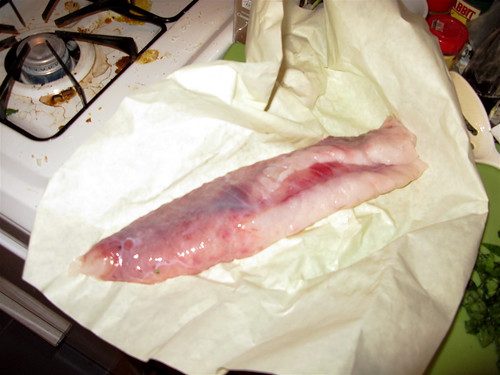
[I actually found it quite difficult to cut away all the dark bits. I did the best I could but, retrospectively, I shouldn't have stressed so much; the dark bits that remained were fine and mostly obscured by the sauce.]
Cut the monkfish fillet into 4 equal portions.

4. Pat the monkfish fillets dry with paper towels and season all over with salt and pepper. Heat the remaining tablespoon of oil in a medium nonstick skillet (9 to 10-inch) over medium high heat. When the oil shimmers, add the fish and saute until it has lost its raw appearance and the outside is pale golden, 4 minutes per side.
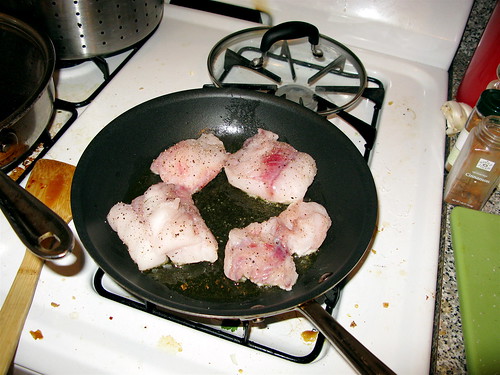
5. Transfer the fillets to the simmering tomato-fennel sauce. With a rubber spatula, scrape any oil or juices from the nonstick skillet onto the fillets. Cover and simmer gently over low heat, turning the fillets after 4 minutes, until the fish is just cooked through, about 8 minutes total.
6. Transfer the monkfish to warm plates. Stir the basil into the sauce, taste for salt and pepper and spoon it around the fish on each plate.
Serve and enjoy!
